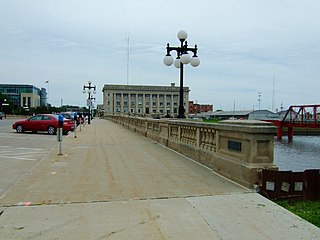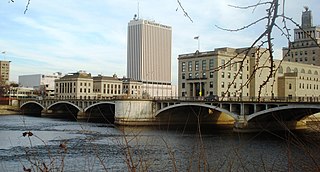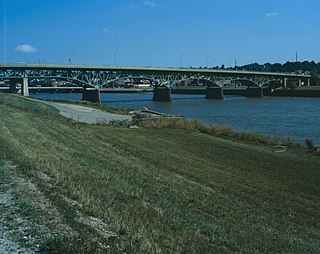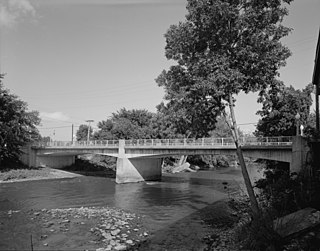
The Anoka–Champlin Mississippi River Bridge, also known as the Ferry Street Bridge, is a 10-span open spandrel concrete deck arch bridge that spans the Mississippi River between Anoka and Champlin, Minnesota, United States. It was built in 1929 by the Minneapolis Bridge Company, replacing an 1884 bridge at the same site.

The Lamar Boulevard Bridge is a historic arch bridge carrying Texas State Highway Loop 343 over Lady Bird Lake in downtown Austin, Texas, United States. The bridge features six open-spandrel concrete arches spanning 659 feet (201 m) and carries tens of thousands of vehicles daily across the lake. Completed in 1942, the Lamar Boulevard Bridge was the second permanent bridge to cross the Colorado River, and one of the last Art Deco-style open-spandrel concrete arch bridges built in Texas. The bridge was named an Austin Landmark in 1993 and added to the National Register of Historic Places in 1994.

The Cornwall Bridge is a two-lane, concrete arch bridge carrying U.S. Route 7/Connecticut Route 4 over the Housatonic River and the Housatonic Railroad in northwestern Connecticut. It was built in 1930 by C.W. Blakeslee and Sons for the Connecticut Highway Department and consists of six open-spandrel arches spanning 674 feet (205 m), and is a fairly large example of concrete open-spandrel construction. The bridge was reconstructed in 1994 and was listed on the National Register of Historic Places in 2004.

The Arrawanna Bridge is a historic bridge, spanning the Coginchaug River near Berlin Street in Middletown, Connecticut, USA. Built in 1918, it is an early example in the state of an open-spandrel concrete arch bridge, and is one of the state's oldest bridges. It was listed on the National Register of Historic Places in 2004. The bridge is now closed to all traffic.

Bridge No. 1132 is an open-spandrel concrete arch bridge carrying the two-lane Connecticut Route 80 across the Hammonasset River, between Killingworth and Madison, Connecticut. Built in 1934, it is one of a small number of open-spandrel concrete bridges in the state, and was noted for its aesthetics at the time of its construction. It was listed on the National Register of Historic Places in 2004.

The Civic Center Historic District is located in downtown Des Moines, Iowa, United States. It flanks both the Des Moines and Raccoon Rivers and their confluence. The district has been listed on the National Register of Historic Places since 1988. It is part of The City Beautiful Movement and City Planning in Des Moines, Iowa 1892—1938 MPS.

The First Avenue Bridge is a historic structure located in downtown Cedar Rapids, Iowa, United States. It carries U.S. Route 151 for 697 feet (212 m) over the Cedar River. The original six-span concrete arch structure was completed in 1920 for $420,000. It was designed by Marsh Engineering Company and built by Koss Construction Co., both of Des Moines. Consulting engineer Ned L. Ashton of Iowa City designed the 1960s remodel. He had all of the concrete work above the original arches torn out and the bridge rebuilt as an open-spandrel structure. The rebuild also included a wider deck to accommodate increased traffic and aluminum railings. While the bridge's original structural integrity has been compromised, this is the first notable concrete spandrel arch reconstruction in Iowa and possibly in the country. The bridge was listed on the National Register of Historic Places in 1998.

The Jefferson Street Viaduct is an historic structure located in Ottumwa, Iowa, United States. The riveted Warren deck truss bridge was completed in 1936. It was listed on the National Register of Historic Places in 1998 as a part of the Highway Bridges of Iowa MPS.

The River Street Bridge over the Iowa River at Iowa Falls, Iowa is an open spandrel bridge built during 1922–1924. It was built by the Weldon Brothers at cost of $16,900, including removal of the previous bridge on the site. It is the fourth bridge constructed on the site, a "pivotal" location in Iowa Falls' development. It has a long span, 140 feet (43 m), and is built with three side-by-side arched ribs supporting concrete pillars.

The Washington Avenue Bridge in Iowa Falls, Iowa is an attractive concrete two-span open spandrel arched bridge that brings Washington Avenue over the Iowa River. Originally it carried US 20. It was built in 1934 by the Weldon Brothers for $51,710.55.

The Alden Bridge is a historic bridge in Alden, Iowa, which carries the town's Main Street over the Iowa River, United States. The concrete bridge is 150 feet (46 m) long and consists of two spans. It was built in 1936 to replace an earlier wooden bridge that had begun to deteriorate. The Weldon Brothers Construction Company supervised the bridge's construction, while the Iowa State Highway Commission designed the structure; it was one of the first bridges designed by the ISHC, which used similar plans for many other bridges in the state. Labor for the construction effort came from the Works Progress Administration, providing jobs for many of Hardin County's unemployed residents. The bridge was dedicated on July 4, 1936, as part of Alden's Independence Day celebrations.

The West Park Bridge across the Sheyenne River in Valley City, North Dakota is a concrete false arch structure that was built in 2007. Together with the corresponding East Park Bridge, it brings Valley City's 4th Street across an oxbow of the Sheyenne River. The bridge is a sympathetic replacement for a historic bridge, built in 1924, that was listed on the National Register of Historic Places in 1997.

Lockyer Creek Railway Bridge is a heritage-listed railway bridge on the Toowoomba–Helidon line over Lockyer Creek at Murphys Creek, Lockyer Valley Region, Queensland, Australia. It was designed by William Pagan and built from c. 1910 to 1911. It was added to the Queensland Heritage Register on 21 October 1992.
The Rockwell City Bridge is located just east of Rockwell City, Iowa, United States. The 60-foot (18 m) span carried traffic on 270th Street over an unnamed stream. In 1915 Calhoun County requested the Iowa State Highway Commission (ISHC) and Des Moines engineer James B. Marsh to design a bridge for this crossing. The ISHC designed a double span concrete girder structure, while Marsh submitted his patented single-span rainbow arch configuration. They chose the Marsh submission, and contracted with the Iowa Bridge Company to build six bridges for $11,690, which included the costs for this bridge at $4,107.65. Originally built to serve a county road, it was later incorporated into the route for U.S. Highway 20 and carried heavy traffic until the highway was realigned in 1981. While no longer in use, the bridge remains in place just south of the replacement span. It was listed on the National Register of Historic Places in 1998.
The Shellsburg Bridge is a historic structure located in Shellsburg, Iowa, United States. It spans Bear Creek for 64 feet (20 m). In April 1915 the Benton County Board of Supervisors contracted with Alfred Vinall to build the new bridge near Shellsburg's downtown area. He used a special design by the Iowa State Highway Commission (ISHC), and completed the project in late 1915 for $6,081.06. The ISHC designed plain bridges for its rural spans, but because this span is in town it features decorative elements: bichrome concrete detailing, molded concrete balustrades, and incised spandrel panels. The bridge was listed on the National Register of Historic Places in 1998.

The Quechee Gorge Bridge is a historic bridge, carrying U.S. Route 4 (US 4) across Quechee Gorge, near the Quechee village of Hartford, Vermont. Built in 1911, it is Vermont's oldest surviving steel arch bridge. It was listed on the National Register of Historic Places in 1990.

The West Broadway Bridge, aka West Street Bridge and the Concrete-Metal Bridge, is a vehicular bridge over the Passaic River in Paterson, New Jersey. It carries West Broadway, traditionally the Paterson-Hamburg Turnpike, and connects to County Route 509 at its west end.

Canal Lake Concrete Arch Bridge is an arch bridge in Ontario, Canada, spanning a portion of Canal Lake on the Trent–Severn Waterway between Balsam Lake and Lake Simcoe. It is north-northeast from the town of Bolsover.

The San Jacinto Street Bridge is a viaduct which crosses Buffalo Bayou in Houston, Texas. The structure is listed on the National Register of Historic Places (NRHP). This bridge was built in 1914 to replace an iron pivot bridge of 1883 origin, and rehabilitated in 1997. It is a transportation conduit connecting downtown and the historical Fifth Ward.

The West Fifth Street Bridge is a historic cantilever concrete girder bridge in downtown Austin, Texas. Built in 1931, the bridge carries Fifth Street across Shoal Creek to link central Austin with neighborhoods that were then the city's western suburbs. It is one of only a handful of curved cantilever girder bridges in Texas, built as part of the city's 1928 master plan for urban development and beautification. The bridge was added to the National Register of Historic Places in 2019.




















